Text
Instagram account @liv_multi deviates from what is traditionally viewed and shows content and accomplishments by multi-racial, multi-ethnic and multi-gender artists and appeals to all. Liv multi is an entity called ‘The Multi Culture Collective”. The Instagram account shares posts about music, art, stories, fashion, cuisine, and celebrities with culturally mixed backgrounds.
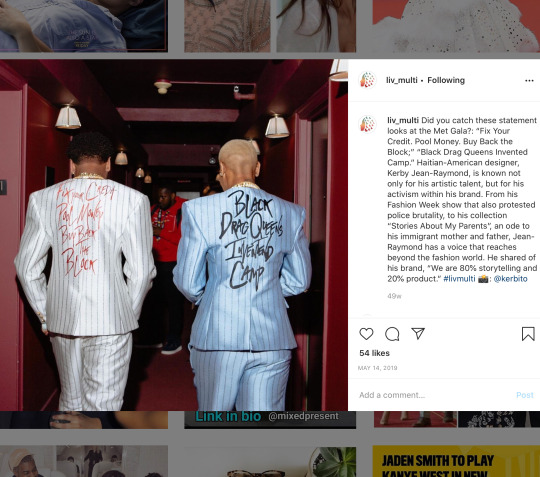
(source: @liv_multi on Instagram)
The collective aspect of Liv Multi is exhibited more on the website, where any artist or influencer can join the community and contribute content, or even sell your work (https://www.livmulti.com/). The @liv_multi account is a snapshot into the concept of a “global village” as discussed by Dr. Lisa Nakamura in her TedX Talk “5 Types of Online Racism and Why You Should Care” about race, ethnicity and identity on the internet (TedX Talks 2011). I see similarities to the arts and culture section of ColorLines.com that we studied in class, but due to the user-driven content I think it’s less curated and more global.
@Liv_multi shifts conversation away from the common culture we’re conditioned to see growing up in America that is Eurocentric and male biased (Jay 2011) and provides the space for multicultural artists to gain exposure, and for anyone to be introduced to happenings in contemporary art, music, film and fashion. Some posts include poetry and reflection.
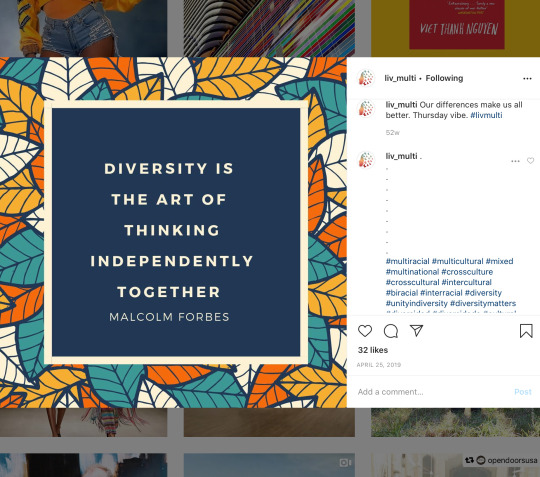
(source: @liv_multi on Instagram)
Others might introduce the viewer to a traditional recipe from another country or culture.
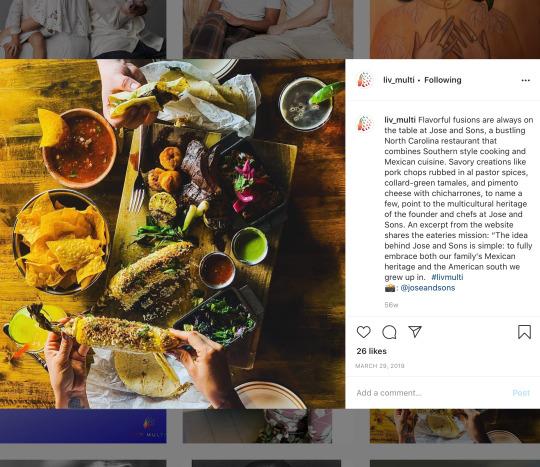
(source: @liv_multi on Instagram)
Some posts might invite critical thought about multiculturalism. For example, one of their posts excitedly points out the multicultural cast of the live action remake of Disney’s movie Aladdin. Is this a triumph, considering the strong orientalist depictions and prejudiced tones of the original cartoon?
This Instagram account might also lead you to the liv multi website, where there’s much more content to stir up conversation. For example in the article by Karmen T (2019), “Dolce & Gabbana: A Lesson in Cultural Sensitivity” she brings to light the alienation that a prominent Italian luxury fashion brand caused when advertising for their Shanghai runway show by depicting a Chinese model trying to eat Italian food with very stereotyped voice (Karmen T). The advertisement was removed, but the sentiment tarnished the brand and the evidence still exists thanks to the Multi Culture Collective. Overall, their messaging is inclusive beyond color lines, entering also into realms of gender and sexuality, and body positivity.
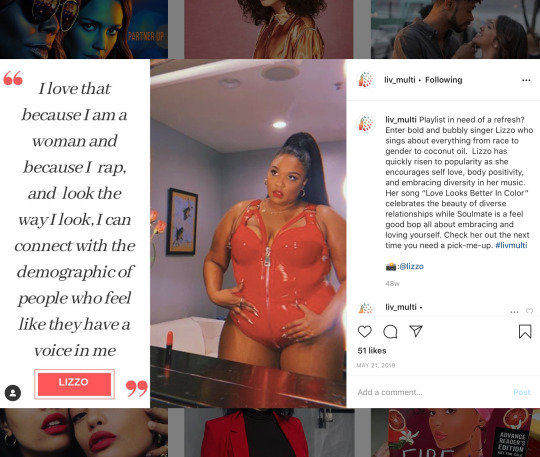
(source: @liv_multi on Instagram)
References:
Chisholm, N., Perkins, Shagorika. Arts & Culture [website]. Retrieved from https://www.colorlines.com/categories/arts-culture
Elam, M., Kina, L., Chang, J., & Oh, E. (2013) Beyond the Face: A Pedagogical Primer for Mixed-Race Art & Social Engagement. Asian American Literary Review. Special Issue on Mixed Race Volume 4, Issue 2: 120-154.
Jay, Gregory. 2011. What Is Multiculturalism? [Unpublished Document]. University of Wisconsin – Milwaukee
Liv Multi. @livmulti [Instagram account]. www.instagram.com/liv_multi
Multi Culture Collective [website]. Retrieved from https://livmulti.com/
TedX Talks. 2011. TEDxUIllinois - Dr. Lisa Nakamura - 5 Types of Online Racism and Why You Should Care [video]. Retrieved from https://www.youtube.com/watch?v=DT-G0FlOo7g
0 notes
Text
In the 1967 comedic drama “Guess Who’s Coming to Dinner” directed and produced by Stanley Kramer, a tense and fast-paced family situation unfolds centered around an interracial engagement between Joanna (Joey) Drayton, a 23-year-old upper-class white woman and Dr. John Prentice, a black 37-year-old medical professor. The film takes place almost entirely at the home of Joey’s parents in San Francisco, as Joey brings John, her now fiancé, home to both meet her parents and at the same time ask for their blessing for marriage, as he is flying to Geneva late that night and Joey wants an immediate answer.
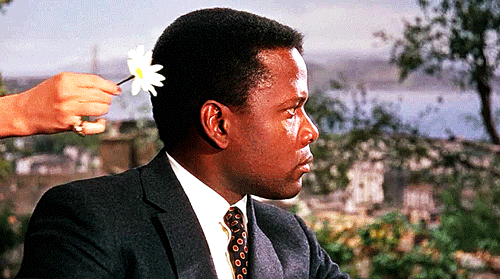
(image source: https://gph.is/2axzY2B)
The Draytons are frustrated by this quick unfolding of events and despite their progressive nature, they are concerned with the interracial marriage. At first Joey’s father, Matt, refuses to give his blessing but ultimately has a change of heart following an impromptu visit from his golf partner, Catholic Monsignor Mike, and John’s parents who fly up from Los Angeles for the night.
This film generates conversation around the evolution of interracial relations in the United States as well as social class status and gender relations. The film was considered progressive at the time, as the Supreme Court case Loving v. Virginia was decided just six months before its release (Loving v. Virginia, 1967).
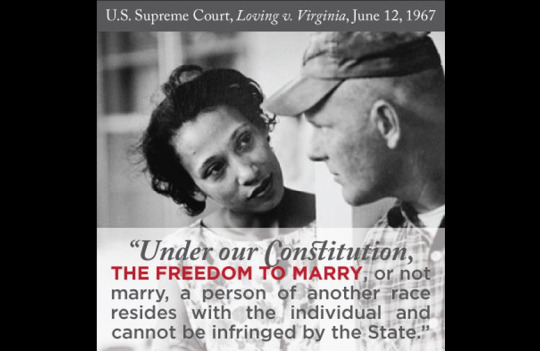
(image source: https://25.media.tumblr.com/aafde49c5748a73f7ee00a8314bed6cc/tumblr_moasfwdeq41rqsvvco1_500.jpg)
The two fathers in the film are in agreement when they first meet that such a marriage will only lead to problems, and they don’t plan on accepting it. They make the argument that the masculine thought is practical and the women, their wives, are caught up in emotions and not thinking clearly, an outdated and misogynist sentiment.
The drama peaks just before dinner, as each character is being pulled into different side conversations where opinions are expressed and eventually culminates in a monologue by Matt, where he ultimately approves of the marriage.
undefined
youtube
(video: https://youtu.be/2wTJfcaezu0)
This film denotates that the fear of miscegenation is still very alive at the time among the older population, even in the elite, educated and progressive white households which is shown by the parents’ initial shock and disapproval. In contrast, it also shows progress where they were welcoming to John’s family and did, in the end, approve of the interracial marriage.
Joey’s character shows the epitome of white privilege. She comes across as aloof, almost in a dreamlike state. She’s constantly ecstatic and overly optimistic. It seems that her rush to marriage is inconsiderate to her partner. Yes, it is sweet that they are so madly in love, but even John has expressed that they may be moving too quickly. It’s apparent that Joey doesn’t consider the issues that he’s going to have coming from both her family and his. She doesn’t seem to be aware of the potential detrimental effects of her class and white privilege.

(image source: https://gph.is/1cq0lmy)
Overall I think the film is definitely worth watching as a piece of cinematic history, and as a sociological study piece. There are many questions that come from the subtleties in character relationships in the premises as a whole. For example, how would Joey’s parents have reacted if John wasn’t an accomplished doctor working for the World Health Organization who spoke like a white person?
References:
Loving v. Virginia, 388 US 1 (1967).
0 notes
Text
“The Night Of”
In the TV series “The Night Of,” the viewer is taken on a journey into the criminal justice system of New York City. It is a fictional story taking place in the year 2014, in a post-9/11 America. The series illustrates racial tensions, a struggle for a positive connotation of middle-eastern identity, the disenfranchisement of people of color in the prison system and dispels the myth of an American’s constitutional right to freedom and justice illustrated by gross abuses of power, inside deals and racial profiling by the court system and media.
The series is comprised of eight 60 to 90 minute episodes, beginning with the introduction to the main character Nasir (Naz) and his Pakistani family.

image: Naz’s parents, Pakistani immigrants (Zailan & Marsh, 2016)
Naz is portrayed as a polite, naïve, educated college student who steals his father’s cab for a night to attend a party in Manhattan. A series of terrible decisions keep unfolding throughout the night, he ends up completely missing the party and also wakes up in the middle of the night in the apartment of a girl he had just met, finding her brutally murdered but having no recollection of what happened between a dangerous cocktail of drugs, sex and then waking up hours later.
As the murder mystery unfolds through the next seven parts Naz is interrogated by a detective who feels the case is open and shut, with circumstantial evidence pointing to Naz as the murderer. He is sent to prison awaiting trial and conviction, and an intense legal battle ensues culminating in the eventual release of Naz due to a gridlocked jury.
Despite the fictional nature of the story, there are a lot of parts inspired by the reality of the United States criminal justice system and the way it operates, as well as racial tensions that permeate our daily lives that are expounded by mass media messaging. The cinematography gives the series a sullen tone through dark lighting and close framing of the actors’ faces especially when in distress.

image: Naz pulled over for an illegal left turn after fleeing Andrea’s home (Zailan & Marsh, 2016)
In the first episodes as the initial events were unfolding, Andrea (the victim) leads Naz to her home where on the way they walk by two Black American men, one of which makes a racist comment toward Naz calling him Mustafa and referencing terrorism. He later recounts to Andrea that this happened sometimes but especially after 9/11. During the trial days, media reports describe Naz as a Muslim rather than Pakistani and they highlight that investigators are looking into any ties to terrorist organizations. The results of the negative media attention pinning the cas as a Muslim attack on a rich American girl disrupted the everyday life of Naz’s family who were now disenfranchised by their community.
When Naz is sent to Rikers he is seemingly the only Middle Eastern inmate among a mostly Black prison population. Racial tensions unfold and Naz quickly learns that there is a hierarchy of inmates the one with the most power has ties to the security and is able to exchange favors. Freddy, the most powerful inmate, offers Naz protection because he takes a liking to the fact that he is smart, educated and seemingly innocent. By the end of the series, Naz looks completely different; he comes out with a shaved head, multiple tattoos and an addiction to heroin. Naz’s stay at Rikers exemplifies the racial injustice that people of color experience related to prison sentences and also shows that innocent convicts eventually become criminally minded as a means to surviving prison life.
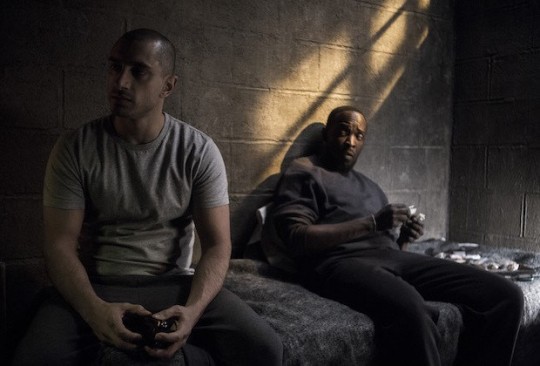
image: Naz and Freddie at Rikers (Zailan & Marsh, 2016)
Lastly, the criminal justice element is deep and complex, and shows that justice for the innocent falls to the back seat to the mood of a police officer, district attorney or lawyer at any given moment as well as their core personalities and convictions.

image: Naz with one of his lawyers (Zailan & Marsh, 2016)
The color of a person’s skin and styling connotate their level of guilt or innocence before a single sentence is exchanged. Andrea was white. She was troubled, had several prior run-ins with the law, used an array of illegal drugs and was portrayed as angelic and sweet. Naz was innocent, in the wrong place at the wrong time and was nearly sentenced to life in prison for a crime he didn’t commit. This is a soft example of the disenfranchisement many citizens of color in America face. It is not uncommon in reality that a retrial would take place and a “Naz” would end up in prison for the rest of his life. Due to the creative direction that stirs emotion and keeps episode endings open-ended causing the viewer to wonder what happens next combined with a “happy-ish” ending, it seems this is a digestible piece of media art that can open the door for more important conversations about the disturbing nature of our legal system.
Source:
Zailan, Steven & Marsh, James. (2016). The Night Of [Television Series]. New York City, US. HBO.
1 note
·
View note